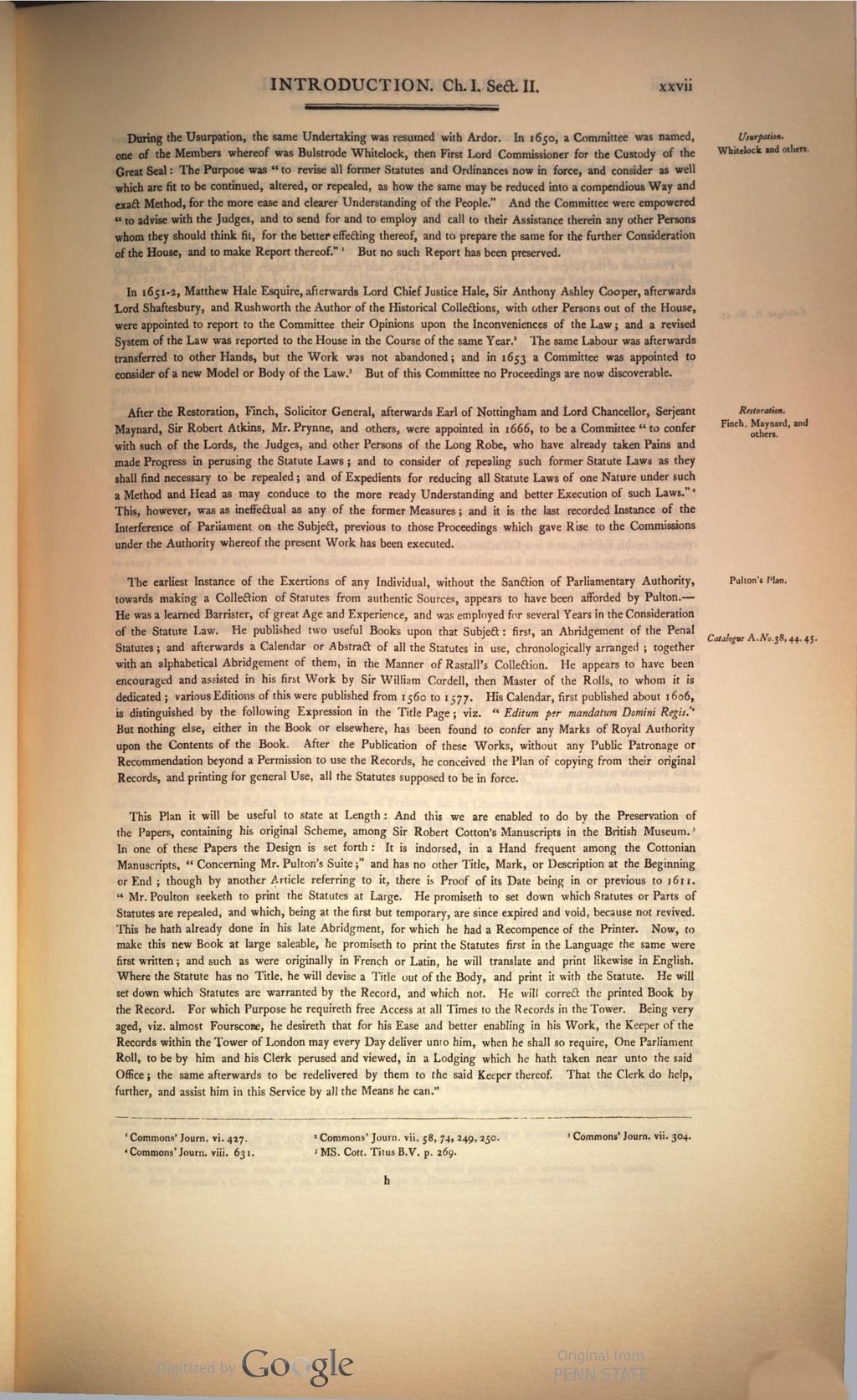During the Usurpation, the same Undertaking was resumed with Ardor. In 1650, a Committee was named, one of the Members whereof was Bulstrode Whitelock, then First Lord Commissioner for the Custody of the Great Seal: The Purpose was “to revise all former Statutes and Ordinances now in force, and consider as well which are fit to be continued, altered, or repealed, as how the same may be reduced into a compendious Way and exact Method, for the more ease and clearer Understanding of the People.” And the Committee were empowered “to advise with the Judges, and to send for and to employ and call to their Assistance therein any other Persons whom they should think fit, for the better effecting thereof, and to prepare the same for the further Consideration of the House, and to make Report thereof.”[1] But no such Report has been preserved.
In 1651-2, Matthew Hale Esquire, afterwards Lord Chief Justice Hale, Sir Anthony Ashley Cooper, afterwards Lord Shaftesbury, and Rushworth the Author of the Historical Collections, with other Persons out of the House, were appointed to report to the Committee their Opinions upon the Inconveniences of the Law; and a revised System of the Law was reported to the House in the Course of the same Year.[2] The same Labour was afterwards transferred to other Hands, but the Work was not abandoned; and in 1653 a Committee was appointed to consider of a new Model or Body of the Law. [3] But of this Committee no Proceedings are now discoverable.
After the Restoration, Finch, Solicitor General, afterwards Earl of Nottingham and Lord Chancellor, Serjeant Maynard, Sir Robert Atkins, Mr. Prynne, and others, were appointed in 1666, to be a Committee “to confer with such of the Lords, the Judges, and other Persons of the Long Robe, who have already taken Pains and made Progress in perusing the Statute Laws; and to consider of repealing such former Statute Laws as they shall find necessary to be repealed; and of Expedients for reducing all Statute Laws of one Nature under such a Method and Head as may conduce to the more ready Understanding and better Execution of such Laws.” [4] This, however, was as ineffectual as any of the former Measures; and it is the last recorded Instance of the Interference of Parliament on the Subject, previous to those Proceedings which gave Rise to the Commissions under the Authority whereof the present Work has been executed.
The earliest Instance of the Exertions of any Individual, without the Sanction of Parliamentary Authority, towards making a Collection of Statutes from authentic Sources, appears to have been afforded by Pulton.—He was a learned Barrister, of great Age and Experience, and was employed for several Years in the Consideration of the Statute Law. He published two useful Books upon that Subject: first, an Abridgement of the Penal Statutes;Catalogue A. No. 38, 44, 45. and afterwards a Calendar or Abstract of all the Statutes in use, chronologically arranged; together with an alphabetical Abridgement of them, in the Manner of Rastall’s Collection. He appears to have been encouraged and assisted in his first Work by Sir William Cordell, then Master of the Rolls, to whom it is dedicated; various Editions of this were published from 1560 to 1577. His Calendar, first published about 1606, is distinguished by the following Expression in the Title Page; viz. “Editum per mandatum Domini Regis.” But nothing else, either in the Book or elsewhere, has been found to confer any Marks of Royal Authority upon the Contents of the Book. After the Publication of these Works, without any Public Patronage or Recommendation beyond a Permission to use the Records, he conceived the Plan of copying from their original Records, and printing for general Use, all the Statutes supposed to be in force.
This Plan it will be useful to state at Length: And this we are enabled to do by the Preservation of the Papers, containing his original Scheme, among Sir Robert Cotton’s Manuscripts in the British Museum.[5] In one of these Papers the Design is set forth: It is indorsed, in a Hand frequent among the Cottonian Manuscripts, “Concerning Mr. Pulton’s Suite;” and has no other Title, Mark, or Description at the Beginning or End; though by another Article referring to it, there is Proof of its Date being in or previous to 1611. “Mr. Poulton seeketh to print the Statutes at Large. He promiseth to set down which Statutes or Parts of Statutes are repealed, and which, being at the first but temporary, are since expired and void, because not revived. This he hath already done in his late Abridgment, for which he had a Recompence of the Printer. Now, to make this new Book at large saleable, he promiseth to print the Statutes first in the Language the same were first written; and such as were originally in French or Latin, he will translate and print likewise in English. Where the Statute has no Title, he will devise a Title out of the Body, and print it with the Statute. He will set down which Statutes are warranted by the Record, and which not. He will correct the printed Book by the Record. For which Purpose he requireth free Access at all Times to the Records in the Tower. Being very aged, viz. almost Fourscore, he desireth that for his Ease and better enabling in his Work, the Keeper of the Records within the Tower of London may every Day deliver unto him, when he shall so require, One Parliament Roll, to be by him and his Clerk perused and viewed, in a Lodging which he hath taken near unto the said Office; the same afterwards to be redelivered by them to the said Keeper thereof. That the Clerk do help, further, and assist him in this Service by all the Means he can.”
